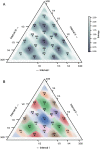Modeling enculturated bias in entrainment to rhythmic patterns
- PMID: 36174063
- PMCID: PMC9553061
- DOI: 10.1371/journal.pcbi.1010579
Modeling enculturated bias in entrainment to rhythmic patterns
Abstract
Long-term and culture-specific experience of music shapes rhythm perception, leading to enculturated expectations that make certain rhythms easier to track and more conducive to synchronized movement. However, the influence of enculturated bias on the moment-to-moment dynamics of rhythm tracking is not well understood. Recent modeling work has formulated entrainment to rhythms as a formal inference problem, where phase is continuously estimated based on precise event times and their correspondence to timing expectations: PIPPET (Phase Inference from Point Process Event Timing). Here we propose that the problem of optimally tracking a rhythm also requires an ongoing process of inferring which pattern of event timing expectations is most suitable to predict a stimulus rhythm. We formalize this insight as an extension of PIPPET called pPIPPET (PIPPET with pattern inference). The variational solution to this problem introduces terms representing the likelihood that a stimulus is based on a particular member of a set of event timing patterns, which we initialize according to culturally-learned prior expectations of a listener. We evaluate pPIPPET in three experiments. First, we demonstrate that pPIPPET can qualitatively reproduce enculturated bias observed in human tapping data for simple two-interval rhythms. Second, we simulate categorization of a continuous three-interval rhythm space by Western-trained musicians through derivation of a comprehensive set of priors for pPIPPET from metrical patterns in a sample of Western rhythms. Third, we simulate iterated reproduction of three-interval rhythms, and show that models configured with notated rhythms from different cultures exhibit both universal and enculturated biases as observed experimentally in listeners from those cultures. These results suggest the influence of enculturated timing expectations on human perceptual and motor entrainment can be understood as approximating optimal inference about the rhythmic stimulus, with respect to prototypical patterns in an empirical sample of rhythms that represent the music-cultural environment of the listener.
Conflict of interest statement
The authors have declared that no competing interests exist.
Figures








References
-
- Sadakata M, Desain P, Honing H. The Bayesian Way to Relate Rhythm Perception and Production. Music Perception. 2006;23(3):269–288. doi: 10.1525/mp.2006.23.3.269 - DOI
-
- Hannon EE, Soley G, Ullal S. Familiarity overrides complexity in rhythm perception: A cross-cultural comparison of American and Turkish listeners. Journal of Experimental Psychology: Human Perception and Performance. 2012;38(3):543–548. - PubMed
-
- Polak R, Jacoby N, Fischinger T, Goldberg D, Holzapfel A, London J. Rhythmic Prototypes Across Cultures. Music Perception. 2018;36(1):1–23. doi: 10.1525/mp.2018.36.1.1 - DOI
Publication types
MeSH terms
LinkOut - more resources
Full Text Sources

